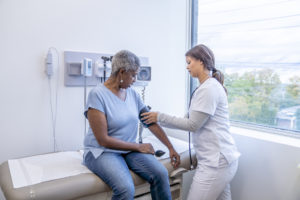Why Do Medical Assistants Take Vital Signs?
 Taking vital signs is one of a medical assistant’s most important responsibilities, but why do body temperature, heart rate and blood pressure matter so much that they’re taken at every visit, even if patients seem well? That’s an interesting question that medical assistants should know the answer to because it improves their understanding of the process and helps them explain it to their patients.
Taking vital signs is one of a medical assistant’s most important responsibilities, but why do body temperature, heart rate and blood pressure matter so much that they’re taken at every visit, even if patients seem well? That’s an interesting question that medical assistants should know the answer to because it improves their understanding of the process and helps them explain it to their patients.
What Are the Different Vital Signs that a Medical Assistant Takes?
Medical assistants take four primary vital signs and up to three secondary vital signs. Primary vital signs include:
Temperature
Normal adult body temperature ranges from 97 to 99 degrees Fahrenheit. It’s measured in one of five ways from orally, under the patient’s tongue, to temporally, over the temporal artery on the forehead. Easy to use, temporal thermometers are the most common in office settings because they’re comfortable, non-invasive, and contact-free.
Pulse
Pulse, or heart rate, is measured in two ways. The most common is by counting pulsations in the radial artery near the wrist as the heart beats. The normal adult heart rate averages 60–100 beats per minute (bpm), but age and physical conditioning make a difference. A toddler’s pulse may be as high as 130 bpm while a performance athlete’s heart rate can be as low as 50 and still be healthy.
You’ll also note the pulse’s rhythm and character. Is it strong and steady or irregular? As a medical assistant, you may be asked to take an apical pulse if the patient has a cardiac arrhythmia. The apical pulse is measured with a stethoscope over the tip, or apex, of the heart.
Respiratory Rate
The average adult breathes 12–16 times per minute. Medical assistants count the number of breaths and their character, are they easy and relaxed, or is the patient struggling to inhale?
Blood Pressure
Blood pressure is the force that blood exerts against the heart and blood vessel walls. Taken with a manual sphygmomanometer or a digital oscillometer, it’s noted as systolic blood pressure, when the heart contracts, over diastolic blood pressure, when the heart is relaxed.
Secondary vital signs, vital signs that are more or less meaningful depending on the type of patient you’re working with include:
Height
Height is a person’s head-to-toe measurement. Taken with a stadiometer consisting of a ruler and a sliding headpiece, it shows height in inches and centimeters.
Weight
Weight is a measurement of relative mass. Even minor changes can be clinically significant. Measured on a professional scale, the same technique should be used every time for accuracy.
Oxygen Saturation
Measured with a fingertip pulse oximeter, oxygen saturation (SpO2) readings are an estimate of oxygen content in the bloodstream. Normal levels range from 90%-98% based on the patient’s medical condition.
Why Do Medical Assistants Take Vital Signs?
Vital signs offer critical information about a patient’s health, not just on a one-time basis, but over time. They help doctors:
Diagnose Illness
Abnormal vital signs are one of the first symptoms of acute illness. A high fever suggests infection while a low SpO2 point could suggest pneumonia. One of the reasons medical assistants take vital signs at every visit is to establish a baseline for comparison. Knowing what’s normal for a particular patient makes it easier to assess changes in their condition.
Determine Risk Factors
Changes in vital signs over time can indicate trouble ahead. A single high blood pressure reading, or a one-time irregular pulse isn’t always meaningful. However, abnormal readings over a months-long period could indicate hypertension or a heart dysrhythmia, conditions that can cause organ failure or death if not treated promptly. Early detection improves clinical outcomes.
Calculate Drug Dosages
The dosage for prescription drugs may vary based on weight or Body Mass Index, a calculation using height and weight that better reflects muscle mass versus body fat percentage. Other medication doses are adjusted based on the patient’s blood pressure, pulse, or SpO2.
Monitor Progress
Treatments for disorders like hypertension should result in lower blood pressure. If it doesn’t, the doctor needs to investigate further to rule out contributing conditions or make changes in the patient’s medications. Regular blood pressure readings are essential for tracking progress.
How Do You Learn to Take Vital Signs?
Vital signs are challenging to learn without the help of a qualified instructor. It’s as important to understand why you take vital signs as how you obtain them.
In a vocational school medical assisting program, you’ll learn the scientific theory behind vital signs and gain practical experience by practicing on peers using the same equipment found in medical facilities. By the time you graduate, you’ll be confident in your techniques and know that your readings are accurate.
What Else Do You Learn During a Medical Assistant Program?
How to take vital signs is just the beginning of what you’ll learn in a medical assisting program. Designed for beginners, the curriculum covers everything you need to be successful in an entry-level position, including:
Medical Terminology
Medical speak is a language of its own. This course won’t turn you into a walking dictionary, but it will help you determine what complicated terms mean based on their prefixes, suffixes, and root words. You’ll be well equipped to decipher doctor’s notes, lab results, and surgical reports.
Anatomy and Physiology
Anatomy and physiology courses explore how the body is made and how it works. You’ll learn about the 14 body systems, their associated disorders, and common treatments so that you can function comfortably in a medical office environment.
Pharmacology
Pharmacology is the study of therapeutic drugs and how they’re used to treat disease. You’ll learn about medications, their therapeutic benefits, potential side effects and how to administer them safely.
Medical Law and Ethics
Healthcare is no ordinary business. It’s highly regulated for public safety and to help workers diagnose legal and ethical issues.
This course will familiarize you with medical law, including patient privacy rights. You’ll discuss the moral dilemmas encountered in the healthcare field and how to respond ethically.
Medical Coding
Medical codes are alphanumerical sequencing systems used to describe symptoms, disorders, treatments, and medical supplies. Used for billing, they reduce volumes of data to standardized terms. Part of your job as a medical assistant will be to use code insurance forms. Accuracy is a must for timely reimbursement.
Phlebotomy
Second only to taking vital signs, drawing blood is among a medical assistant’s most valuable skills. You’ll learn how to take and process samples in a laboratory environment by practicing on computers and simulation devices, moving on to patients during off-site clinical externships.
Diagnostic Testing
Medical assistants learn to perform electrocardiograms and other diagnostics such as urinalyses, occult fecal blood tests, and pregnancy tests. Graduates are prepared to work safely in a lab.
Office Procedures
Medical assistants perform both clinical and clerical tasks. Vocational school programs prepare students for both, covering general office procedures from data entry to writing correspondence. You’ll learn how to access, use, and store information in electronic health records.
Final Thoughts
Medical assistants have a broad range of clinical responsibilities, but taking vital signs is among the most consequential. It’s a priceless contribution to patient wellness.
Want to Learn More?
Ohio Business College’s Medical Assisting training program will prepare you for a career as a medical assistant capable of working in any medical office or facility. Our school’s caring instructors have real world experience and will teach you the necessary skills to succeed in the medical assisting profession over the course of our comprehensive training program.
Contact us today to learn more about our Medical Assistant programs.

